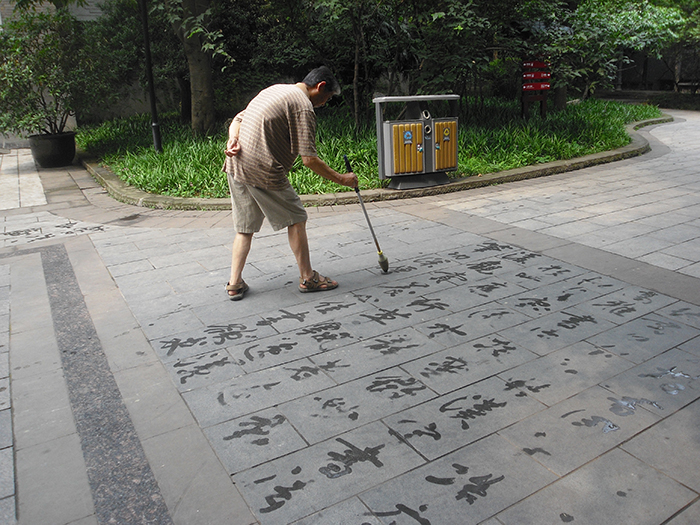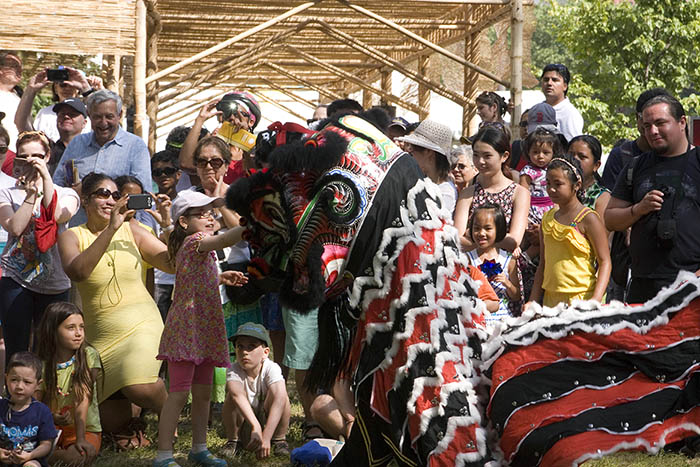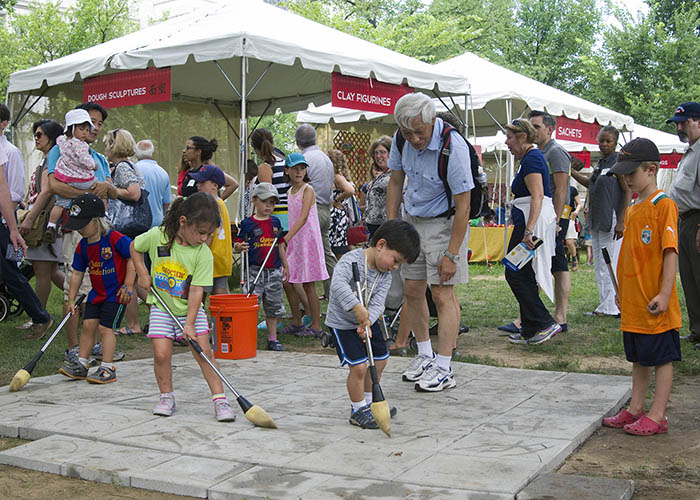I Love People’s Park—Damaged Badminton Rackets and Sound Bleed Aside

You can’t even hear yourself think, let alone someone else speaking, when you’re standing between two competing karaoke stations. So we just kept moving through the covered walkway in the middle of the park, passing a young man playing a flute and further down an old man bowing away on his erhu. Nearby, beyond a row of hedges, a group of dancing women pivoted, their fans held high, the sound bleed of their recorded musical accompaniment adding yet another layer to the clamorous soundtrack of our jaunt through People’s Park in Chengdu, Sichuan Province.
I love People’s Park. Both the real one described above as well as the one we recreated at the 2014 Smithsonian Folklife Festival’s China: Tradition and the Art of Living program. And let me qualify this enthusiasm—it comes from that place of incomplete knowing and naivete inherent in an outsider’s preconceptions and interpretation of something that is at once familiar, surprising, and aspirational.
The China program’s “People’s Park” was in the central open space near the crafts demonstrations—strategically situated to receive some degree of shade during the hottest hours of the afternoon and so that it could knit together the quieter activity areas along the edges of the site. We planned the space to be a celebration of public life in China and envisioned it as a dynamic hub—always teeming with activity, inviting participation, yet also providing a comfortable space for socializing, resting, and aimlessly hanging out.
We were first introduced to People’s Park in Chengdu, exhorted by our advisor Jean Miao, to see how regular people (versus master artists) were publicly engaging in traditional arts and creative activities. Strolling through only a small section of it, we passed through mahjong games, karaoke singing, live ensemble music playing, fan dancing, and water calligraphers. In later visits to Beijng parks, we observed much of the same, plus the marriage-brokering transactions among parents and other third parties, as well as fantastic performances of narrative singing (kuai ban), ballroom dancing, traditional theater routines, tai chi, table tennis, and Chinese chess.

“Park culture is something that’s so common and ordinary in China that it’s often overlooked as a true demonstration of everyday folk traditions,” Miao explained. “Anyone can join in and sing, dance, play games, and write calligraphy. It’s about active participation rather than passive observing. The ‘artists’ are engaged in creating art not for the benefit of an audience. These aren’t performances; they’re just regular people engaged in creative expression.”
These parks in China have captured the imagination of many a foreigner. At least two films have been made on the topic, one specifically focused on Chengdu’s People’s Park. Some of this attention can verge on fetishistic—surprised as we outsiders are to discover a citizenry that includes jolly, creative, and eccentric characters. It can also strike a melancholic note when considering that many park regulars are from a generation of retirees in their fifties and early sixties who came of age during the Cultural Revolution.
Still, there is something impressive about the particular energy and unselfconsciousness of public life in China. And with this as our inspiration, we developed the idea a People’s Park on the National Mall that would add energy to China program, reinforce the contemporary context of Chinese culture and tradition, provide a more informal space for featuring performers aside from the large 600-seat tented stage, invite meaningful interaction between the Chinese participants and American visitors, and engage local practitioners of Chinese martial arts and dance forms.

The Festival’s People’s Park was anchored by a covered bamboo walkway lined with benches, surrounded by a badminton net, a concrete surface for water calligraphy, and a weiqi (go) playing area. We enlisted the help of several local organizations and artists, collaborating with their Chinese counterparts on demonstrations, workshops, and performances.
Fairly quickly—as in, during the first hour of the first day of the Festival—we realized our missteps in presenting performing artists in this area. Though we had communicated with the Chinese artists in advance of their arrival in Washington, we had not sufficiently managed their expectations. We had prioritized our judgments over the artists’ preferences.
Specifically, we had decided that the flower drum lantern dancers and hua’er folk singers would be more accessible to American audiences in People’s Park. We wanted to bring audiences close to the artists and show a more informal dimension of their traditions. After all, flower drum lantern is a form of dance that has been adapted into the exercise regimens commonly practiced in parks, and the traditional context for hua’er singing in northwestern China is in open air.
These particular artists who came to the Festival, however, are accustomed to highly produced stage presentations, and as a result they adjusted to our format with different degrees of comfort and flexibility. While our production values are not inclined toward sequined costumes, fancy lighting, and recorded music accompaniment, these are common features in staged Chinese presentations of traditional arts. Accordingly, the artists were perplexed by our objections to using “playback” music, and they may have also wondered about the modest staging of their presentations in People’s Park relative to the main stage.

Though our People’s Park environment represented just a pale shadow of the naturally occurring, expansive activity of its real-life Chinese counterpart, I still consider the effort worthwhile. Our park was a contrivance, an interpretive device that we deployed to frame certain activities and encourage interaction. And that is what we do at the Festival. We reinterpret. We transplant performances from one place and re-present them in another altogether foreign and discontinuous context—to varied and sometimes questionable effect.
“The difficult part about People’s Park is that it was an imagined space,” said Joan Hua, program assistant who coordinated and presented the local artists. “My biggest fear was that it would be a deserted or forced space. What we had to do was to plant a seed—have one person start kicking the jianzi (shuttlecock), for example—and then encourage other visitors to join in. That’s when the People’s Park is present.”
Virtually every day, I lingered around the park, taking in the sight of the tiny martial arts students from the Virginia-based U.S. Wushu Academy lining up to demonstrate with the Beijing Sports Academy performers; the assortments of visitors spiritedly trying to pass the jianzi through the air to one another; the flower drum lantern dancers processing across the site, their fans fluttering in bursts of color; groups of people gathering around Chinese chess or go boards; and families seated along the covered walkway eating their lunches.

I can forgive the visitors who warped half of the badminton rackets and left all but one jianzi irreparably lopsided. I can overlook the fact that many younger visitors used the water calligraphy brushes not to write beautifully shaped verse, but rather to saturate the concrete pavers. And I am okay with the fact that the playback music for flower drum sounded like a movie soundtrack, and that on the last day of the Festival, the lion dance percussion momentarily drowned out the presentations at the narrative and foodways demonstration stages.
This is all okay, I have realized. Because in sum, it all contributed to the fine public cacophony of many people energetically, and according to their own diverse sensibilities, exerting their will to participate, create, and communicate.
Sojin Kim is a curator at the Center for Folklife and Cultural Heritage and co-curated the China program at the 2014 Folklife Festival.

